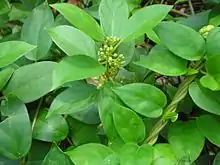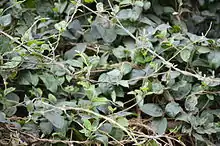Gymnema sylvestre
Gymnema sylvestre[1] is a perennial woody vine native to tropical Asia, China, the Arabian Peninsula, Africa, and Australia. It has been used in Ayurvedic medicine. Common names include gymnema,[2] Australian cowplant, and Periploca of the woods, and the Hindi term gurmar, which means "sugar destroyer".[3][4][5]
| Gymnema sylvestre | |
|---|---|
 | |
| Gymnema sylvestre, at Eastern Ghats, India | |
| Scientific classification | |
| Kingdom: | Plantae |
| Clade: | Tracheophytes |
| Clade: | Angiosperms |
| Clade: | Eudicots |
| Clade: | Asterids |
| Order: | Gentianales |
| Family: | Apocynaceae |
| Genus: | Gymnema |
| Species: | G. sylvestre |
| Binomial name | |
| Gymnema sylvestre | |
The leaves and extracts contain gymnemic acids, the major bioactive constituents that interact with taste receptors on the tongue to temporarily suppress the taste of sweetness.[6][7][8][9][10]
Description
The plant is a climber with leaves having soft hairs on the upper surface. The leaves are elongated-oval in shape. It has a small, yellow, umbelliferous inflorescence that is produced throughout the year.[11]
Properties
Gymnema sylvestre has a long history of use in herbal medicine and a broad range of therapeutic properties.[4][5][12]
Blocks sweet taste sensations
Its leaves contain triterpenoid saponins,[13][14][15] flavonols,[16] and gurmarin.[5] The major biologically active plant molecules are gymnemic acids, a class of triterpenoid saponins, which have the effect of suppressing the taste of sweetness on the tongue from sucrose (sugar), stevia, xylitol, and artificial sweeteners such as aspartame.[17]
The sweet-blocking effect of G. sylvestre lasts from 15[6] to 50 minutes[18] and may even persist for several hours.[19] Gymnemic acids apparently have no long-term effects on taste and they do not influence bitter, salty, or sour taste perception.[7][20]
Uses
- Reduction of sugar intake: G. sylvestre extracts taken in the form of lozenges, mouthwash, or tea diminishes the consumption of sweet foods and overall caloric intake. Extracts (formulated as a mint lozenge) reduced the desire for high-sugar foods and the pleasant taste of candy.[22] Research also suggests that Gymnema sylvestre extracts reduce cravings for sugar. In a double-blind study, participants who received a gymnemic acid lozenge declined candy (before tasting it) more often than the placebo group.[10][23][24]
- Diabetes: Early research suggests when a specific gymnema extract (GS4) is taken orally along with insulin or diabetes medications, blood sugar reduction in people with type 1 or type 2 diabetes is enhanced.
- Weight loss: In Japan, 50 tons of G. sylvestre leaves are consumed annually for the purpose of weight loss.[25][26] Early research suggests that taking a specific combination of Gymnema sylvestre extract, hydroxycitric acid, and niacin-bound chromium by mouth for 8 weeks might reduce body weight in people who are overweight or obese.[27]
- Traditional uses: In Eastern and Ayurvedic medicine, G. sylvestre leaves and extracts have been used to treat eye diseases, allergies, constipation, cough, dental caries, obesity, stomach ailments, and viral infections. G. sylvestre has also been used as an antioxidant, antimicrobial, and aphrodisiac.[5][14][25]
Etymology

Gymnema derives from the Greek words gymnos (γυμνὀς) and nēma (νῆμα) meaning "naked" and "thread", respectively; the species epitheton sylvestre means "of the forest" in Latin.[28]
The Hindi and Urdu name gurmar, Sanskrit madhunashini, Malayalam chakkarakolli, and Telugu podapatri, literally mean "sugar destroyer". (Sanskrit) meshasringa translates as "ram's horn", a name given to the plant due to the shape of its fruits.
References
- "Integrated Taxonomic Information System". www.itis.gov. Retrieved 2018-02-01.
- Duke JA, ed. (2002). Handbook of medicinal herbs (2nd ed.). CRC Press. p. 855. ISBN 978-0-8493-1284-7.
- Quattrocchi U (1999-11-23). CRC World Dictionary of Plant Names: Common Names, Scientific Names, Eponyms, Synonyms, and Etymology. Taylor & Francis US. ISBN 9780849326769.
- Tiwari P, Mishra BN, Sangwan NS (2014). "Phytochemical and pharmacological properties of Gymnema sylvestre: an important medicinal plant". BioMed Research International. 2014: 830285. doi:10.1155/2014/830285. PMC 3912882. PMID 24511547.
- Ulbricht C, Abrams TR, Basch E, Davies-Heerema T, Foppa I, Hammerness P, Rusie E, Tanguay-Colucci S, Taylor S, Ulbricht C, Varghese M, Weissner W, Woods J (2011). "An evidence-based systematic review of gymnema (Gymnema sylvestre R. Br.) by the Natural Standard Research Collaboration". Journal of Dietary Supplements. 8 (3): 311–30. doi:10.3109/19390211.2011.597977. PMID 22432729. S2CID 29228955.
- Kurihara Y (1969). "Antisweet activity of gymnemic acid A1 and its derivatives". Life Sciences. 8 (9): 537–43. doi:10.1016/0024-3205(69)90449-4. PMID 5791706.
- Gent JF, Hettinger TP, Frank ME, Marks LE (1999). "Taste confusions following gymnemic acid rinse". Chemical Senses. 24 (4): 393–403. doi:10.1093/chemse/24.4.393. PMID 10480675.
- Sanematsu K, Kusakabe Y, Shigemura N, Hirokawa T, Nakamura S, Imoto T, Ninomiya Y (September 2014). "Molecular mechanisms for sweet-suppressing effect of gymnemic acids". The Journal of Biological Chemistry. 289 (37): 25711–20. doi:10.1074/jbc.M114.560409. PMC 4162174. PMID 25056955.
- Gardner Z, McGuffin M (2013-03-15). American Herbal Products Association's Botanical Safety Handbook, Second Edition. CRC Press. ISBN 9781466516946.
- Brala PM, Hagen RL (January 1983). "Effects of sweetness perception and caloric value of a preload on short term intake". Physiology & Behavior. 30 (1): 1–9. doi:10.1016/0031-9384(83)90030-6. PMID 6836034. S2CID 21639511.
- Drury H (1869). Hand-book of Indian Flora. Madras: Trabancore Sircar Press. p. 232. ISBN 978-1-143-66359-8.
- Yeh GY, Eisenberg DM, Kaptchuk TJ, Phillips RS (April 2003). "Systematic review of herbs and dietary supplements for glycemic control in diabetes". Diabetes Care. 26 (4): 1277–94. doi:10.2337/diacare.26.4.1277. PMID 12663610.
- Dateo GP, Long L (September 1973). "Gymnemic acid, the antisaccharine principle of Gymnema sylvestre. Studies on the isolation and heterogeneity of gymnemic acid A1". Journal of Agricultural and Food Chemistry. 21 (5): 899–903. doi:10.1021/jf60189a030. PMID 4733385.
- Di Fabio G, Romanucci V, Di Marino C, Pisanti A, Zarrelli A (2015). "Gymnema sylvestre R. Br., an Indian medicinal herb: traditional uses, chemical composition, and biological activity". Current Pharmaceutical Biotechnology. 16 (6): 506–16. doi:10.2174/138920101606150407112903. PMID 25860062.
- Sinsheimer JE, McIlhenny HM (1967). "Constituents from Gymnema sylvestre leaves. II. Nitrogenous compounds". Journal of Pharmaceutical Sciences. 56 (6): 732–6. doi:10.1002/jps.2600560615. PMID 6039815.
- Liu X, Ye W, Yu B, Zhao S, Wu H, Che C (March 2004). "Two new flavonol glycosides from Gymnema sylvestre and Euphorbia ebracteolata". Carbohydrate Research. 339 (4): 891–5. doi:10.1016/j.carres.2003.12.017. PMID 14980834.
- Frank RA, Mize SJ, Kennedy LM, de los Santos HC, Green SJ (1992-10-01). "The effect of Gymnema sylvestre extracts on the sweetness of eight sweeteners". Chemical Senses. 17 (5): 461–479. doi:10.1093/chemse/17.5.461.
- Meiselman HL, Halperin BP (1970). "Human judgments of Gymnema sylvestre and sucrose mixtures". Physiology & Behavior. 5 (8): 945–8. doi:10.1016/0031-9384(70)90187-3. PMID 5522511.
- US application 2004071801, Edell D, Handel R, "Herbal formulation of Gymnema sylvestre as a dietary aid", published 15 April 2004
- Riskey DR, Desor JA, Vellucci D (1982-01-01). "Effects of gymnemic acid concentration and time since exposure on intensity of simple tastes: A test of the biphasic model for the action of gymnemic acid". Chemical Senses. 7 (2): 143–152. doi:10.1093/chemse/7.2.143. ISSN 0379-864X.
- Tiwari, P; Mishra, BN; Sangwan, NS (6 January 2002). "Phytochemical and pharmacological properties of Gymnema sylvestre: an important medicinal plant.". BioMed Research International. 2014: 830285. doi:10.1155/2014/830285. PMC 3912882. PMID 24511547.
- Stice, Eric. "Two clinical studies confirm that Sweet Defeat reduces desire for sugar and sugar consumption".
- Clinical trial number NCT02744885 for "Crave Crush Behavioral Study" at ClinicalTrials.gov
- Stice E, Yokum S, Gau JM (2017). "Gymnemic acids lozenge reduces short-term consumption of high-sugar food: A placebo controlled experiment". Journal of Psychopharmacology. 31 (11): 1496–1502. doi:10.1177/0269881117728541. PMID 28944714. S2CID 46836377.
- Ogawa Y, Sekita K, Umemura T, Saito M, Ono A, Kawasaki Y, Uchida O, Matsushima Y, Inoue T, Kanno J (February 2004). "[Gymnema sylvestre leaf extract: a 52-week dietary toxicity study in Wistar rats]". Shokuhin Eiseigaku Zasshi. Journal of the Food Hygienic Society of Japan. 45 (1): 8–18. doi:10.3358/shokueishi.45.8. PMID 15168555.
- Ueno M (1993). "The bioactivity and use of the sugar absorption inhibitor "Gymnema sylvestre"". Technical Journal on Food Chemistry & Chemicals. 12: 21–26.
- Preuss, H.G. (2004). "Effects of a natural extract of (-)-hydroxycitric acid (HCA-SX) and a combination of HCA-SX plus niacin-bound chromium and Gymnema sylvestre extract on weight loss". Diabetes Obes Metab. 6 (3): 171–80. doi:10.1111/j.1462-8902.2004.00328.x. PMID 15056124. S2CID 36237508.
- Wikisource:The New International Encyclopædia/Gymnema
Further reading
- Ambasta SP (1986). The useful plants of India. New Delhi: Publications & Information Directorate, Council of Scientific & Industrial Research. ISBN 978-81-85038-02-5.